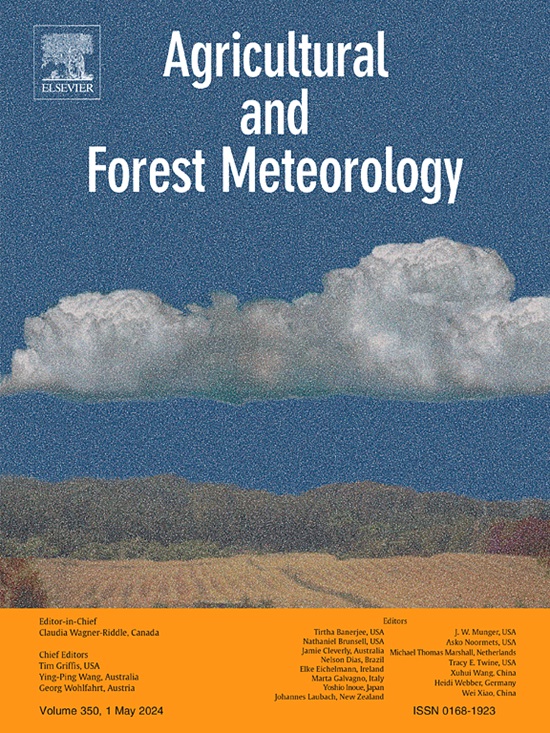温带混交林生理应激阈值序列对干旱的响应
IF 5.6
1区 农林科学
Q1 AGRONOMY
引用次数: 0
摘要
预测全球干旱对森林的影响仍然受到限制,因为在定义水分胁迫下的生理功能障碍时,缺乏对性状相互作用的机制理解,特别是在植物气孔调节和水力学之间的相互作用方面。本研究对中国东北地区17种温带木本植物叶片和茎干的气孔和水力性状进行了研究。研究发现,气孔关闭点(最大气孔导度损失88%时的水势)与叶片膨胀损失、茎导率和茎导率损失50%时的水势呈正相关。所有研究物种的叶片水力导度损失的50%发生在50%的茎栓塞之前,这与脆弱性分割假说一致。几乎所有被研究的树种在茎栓塞50%之前达到气孔完全关闭,但在叶片水力导度损失50%之后。总的来说,观察到的关键生理功能障碍水势序列不仅有助于尽可能长时间的碳同化,而且有助于避免高建设成本的木质茎水力功能的大量丧失。气孔调节与多种水力性状之间的相互作用可能扩大到影响整个植物的水分利用。本文章由计算机程序翻译,如有差异,请以英文原文为准。
The sequence of physiological stress thresholds responses to drought in a temperate mixed forest
Predicting the influence of worldwide drought on forests remains constrained by lacking of mechanistic understanding of trait interactions in defining physiological dysfunction under water stress, particularly with respect to the interaction between plant stomatal regulation and hydraulics. In this study, we investigated key stomatal and hydraulic traits of leaves and stems for 17 temperate woody species in northeastern China. We found that the stomatal closure point (the water potential at 88 % loss of maximum stomatal conductance) was positively correlated with the water potentials at leaf turgor loss, stem hydraulic conductivity, and 50 % loss of stem hydraulic conductivity. The 50 % loss of leaf hydraulic conductance of all studied species occurred before 50 % stem embolism, in agreement with the vulnerability segmentation hypothesis. Almost all studied tree species reached complete stomatal closure before 50 % stem embolism, but after the 50 % loss of leaf hydraulic conductance. Collectively, the observed sequence of water potential for key physiological dysfunctions not only facilitates carbon assimilation for as long as possible, but also helps to avoid substantial loss of the hydraulic function in woody stems with high construction costs. The interactions between stomatal regulation and multiple hydraulic traits may scale up to influence the water use of whole plants.
求助全文
通过发布文献求助,成功后即可免费获取论文全文。
去求助
来源期刊
CiteScore
10.30
自引率
9.70%
发文量
415
审稿时长
69 days
期刊介绍:
Agricultural and Forest Meteorology is an international journal for the publication of original articles and reviews on the inter-relationship between meteorology, agriculture, forestry, and natural ecosystems. Emphasis is on basic and applied scientific research relevant to practical problems in the field of plant and soil sciences, ecology and biogeochemistry as affected by weather as well as climate variability and change. Theoretical models should be tested against experimental data. Articles must appeal to an international audience. Special issues devoted to single topics are also published.
Typical topics include canopy micrometeorology (e.g. canopy radiation transfer, turbulence near the ground, evapotranspiration, energy balance, fluxes of trace gases), micrometeorological instrumentation (e.g., sensors for trace gases, flux measurement instruments, radiation measurement techniques), aerobiology (e.g. the dispersion of pollen, spores, insects and pesticides), biometeorology (e.g. the effect of weather and climate on plant distribution, crop yield, water-use efficiency, and plant phenology), forest-fire/weather interactions, and feedbacks from vegetation to weather and the climate system.

 求助内容:
求助内容: 应助结果提醒方式:
应助结果提醒方式:


